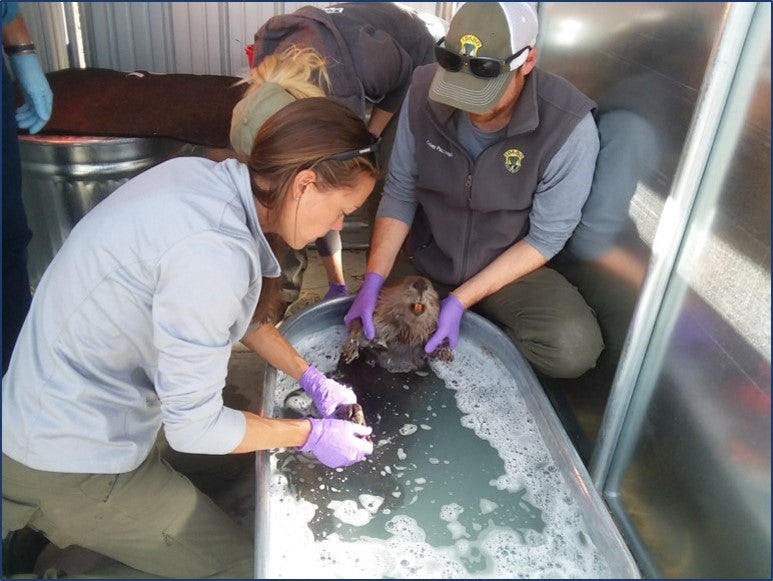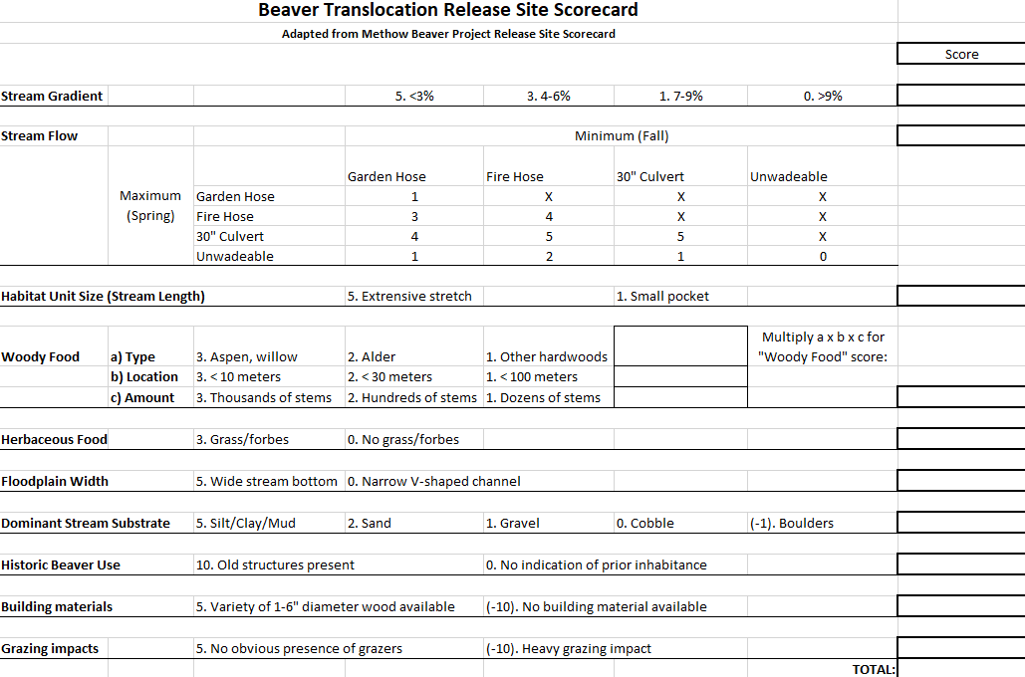Examining Translocation (Using Soft Release Methods) of the American Beaver (Castor canadensis) Within the State of Idaho
Ian C. Pickens, Scott T. Cook, Rebecca J. Bouley, Dr. Emily Wakild

Introduction
Idaho has been actively translocating beavers since the early 1980s using hard release methods (Mosby, 2020). This is a short and easy method of transfer. However, more recently, Idaho has started implementing soft release translocation processes. These processes include beaver health exams, cleaning, holding at special facilities, and post-release tracking. This method of translocation will hopefully become the new standard, however, it is up to the individual regions in Idaho to decide (Mosby, 2020). Soft releases are the focus of this research paper because of the projected benefits the associated processes provide. According to Cory Mosby, the purpose of translocation in Idaho is not to promote beaver populations, but to use the animal as a tool for habitat restoration. This keystone species is essential in its ability to promote biodiversity and restore riparian areas to a healthier state.
Translocation using soft release methods is not a simple process and needs to be carefully planned out before it’s attempted. Information from existing research highlights certain steps and procedures that should be followed to increase the success of translocation. Unfortunately, due to increasing popularity and lack of information on translocation, there are still many risks associated with translocation. Idaho Fish and Game and other wildlife management professionals assume responsibility for many beavers’ lives during this process in order to increase project success and reduce the risks associated with release. All of this work is well worth doing if the translocation is successful.
Cost Estimates
| Equipment | Cost |
|---|---|
| Technicians (Entry level) | $14.50/hour ($21.75 for every hour past 40 each week) |
| Truck | $260/month lease + $0.55/mile fee |
| Boat | $200/month lease + $1.15/mile fee |
| Chemical Immobilization Drugs | $35.00/animal (Budget should account for additional doses and poor deliveries.) |
| Radio Transmitters | $150-300/animal |
| Transportation Cages | $30 each |
| Trapping (Private trappers) | $150/animal |
| Incidental Costs | 5-7% of overall budget |
| Food (Mazuri Rodent Pellets) | $35/one 50 lb bag |
The Translocation Process
1. Pre-Planning Activities
The short and long term financial considerations of the project need to be assessed, as well as the potential impacts to local landowners and public infrastructure. It’s also important to acquire all necessary permits and/or permissions from agencies and property owners. Coordinate and determine roles of multi-agency projects that are directly or indirectly involved in the project. Develop a program schedule which plans for capture, transport, quarantine, and monitoring.
2. Site Selection
Beavers in Idaho are translocated to wildlife management areas owned by the Idaho Department of Fish and Game, public land, or private land if the owners agree to it (Utz, 2020). The specific site selections are based on a scorecard used to record metrics such as stream flow, food availability, building materials, and historic beaver use. Currently, a single scorecard is primarily used regardless of location to determine habitat suitability for translocation. Because some ecosystems are more fragile than others, it has been proposed that Idaho-specific scorecards and translocation processes be individually developed. Another important tool in assessing potential translocation sites for beaver is through the use of computer Geographical Information Systems (GIS) and the BRAT tool. This helps determine the appropriateness of streams and surrounding habitat for beavers. It’s important to know where they will be able to effectively build dams. Also, according to Jamie Utz, speaking with people who may be affected by beaver translocation and explaining how the process will benefit them prior to the beaver’s translocation tends to quell concerns and prevent inflammation of the situation. Evaluating the public’s attitude and support for a project is critical in determining the overall suitability of a site.
3. Trapping & Transport
Idaho Fish and Game mostly relies on private trappers that use live catch traps such as the Hancock trap and live snaring (Utz, 2020). The traps must be checked at least every 24 hours because of predator threats (Utz, 2020). During transport, it’s important to take precautions to minimize the stress of the animal and avoid overheating.
4. Holding Facility
Beavers go through a 72 hour process while in the Boise holding facility. Beavers should be held only for a short time frame to avoid putting the beavers at risk of contracting or exacerbating pathogens and to avoid causing prolonged, harmful stress (Utz, 2020). Beavers are put in spacious kennels and provided with food, water, and a place to hide to escape human attention (Mosby, 2020). This process could use a few improvements, including thatched fences to hide the beavers from humans to reduce exposure to unnatural stress (Utz, 2020) and modification to facilitate socialization of the captive animals (Mosby, 2020).
5. Examination and Cleaning

While the beavers are in holding facilities, they undergo an examination and cleaning process to avoid pathogen and invasive species transmission. The beavers are initially monitored for wounds and suspicious behavior and are then anesthetized and cleaned with Dawn dish soap (Utz, 2020). After this, they will be completely dried out to further ensure that pathogens and any invasive species or spores are dead. Finally, their fur is re-oiled (Utz, 2020).
6. Tracking
Tail tags aren’t given to every beaver that comes through the Boise holding facility because installation of the tag is an intrusive process that requires wildlife professionals to drill through the beaver’s tail (Utz, 2020). These tail tags are useful after release in determining the location and wellbeing of the released beavers.
7. Site Preparation & Release
Idaho avoids picking release sites that need a lot of preparatory work due to a deficiency in time and resources (Utz, 2020). However, Cory Mosby suggests that building a series of Beaver Dam Analogues along a drainage might increase the chances of a translocated individual, couple, or family settling into the target watershed. The best release time is late summer or early fall so that beavers are more likely to establish a home and prepare for winter (Malcolm, n.d., 38).
8. Post Monitoring
Wildlife professionals will frequently visit for the first week after release to listen for the tail tag, if the released individual has one, to make sure they are still alive. The first two weeks after translocation tend to be the most dangerous for translocated beavers (Utz, 2020). Due to this danger, monitoring is critical during the first two weeks. Post-release monitoring practices vary throughout Idaho, and monitoring is simply forgone in some projects. However, short and long-term monitoring is critical in not only evaluating the health of released animals but in evaluating environmental impacts within the release site and surrounding area. Regular monitoring of translocated beavers provides important feedback in assessing the success of the project and program.
Methods
Our initial research included a review of both primary and secondary sources made available through our exploration of the American Beaver (Castor canadensis) in class and through independent research. These sources gave specific examples for mitigating risk, and provided opportunities to formulate new approaches and methods. Although not all of our sources directly addressed beaver translocation, they were still valuable in answering our questions regarding beaver translocation processes. To further address our research question, we conducted interviews with professionals who work with beaver translocation and the associated risks. This was determined to be the best approach due to the lack of available information on beaver-specific translocation in Idaho coupled with recent implementations of the idea as a tool for habitat restoration. We conducted three total interviews. The first interview was with Idaho’s State Furbearer Biologist, Cory Mosby. The second one was with Idaho Fish and Game Senior Wildlife Technician, Jamie Utz, and the final one was with Geomorphologist and Hydrologist, Dr. Caroline Nash. We now have a holistic understanding of the beaver translocation process in the State of Idaho and cost estimates for these projects.
Risks
- Pathogens
- Expenses
- Invasive species transfer
- Unnecessary stress and immunosuppression
- Low survival rates
- Predators
- Emigration
- Deficiency in resources: food, cover, deep pools, etc.
- Unpredictability: Beavers don’t always build dams
- Human conflict
- Damage liability
- Project failure
Benefits
The most important benefit of translocation in Idaho is habitat restoration (Utz, 2020). This will benefit almost every species in the area, including endangered species such as sage grouse, columbian spotted frogs, and red band trout (Mosby, 2020). When beavers build dams, they impound water and retain sediment, and this positively alters the physical, chemical, and biological characteristics of the riparian ecosystem (Pollock et al., 2015, vi). Some examples of positive changes they make are greater habitat complexity, better water quality, expanded wetlands, higher summer base flows, increased groundwater recharge, increased nutrient cycling, and increased diversity in plants, birds, fish, amphibians, reptiles, and mammals (Pollock et al., 2015, vi). They also stand to benefit cattle operations by increasing feeding opportunities. All of these things and many more contribute to mitigating the worldwide problem of climate change (Malcom, n.d., 43). Beavers are a natural and necessary tool that should be reintroduced (Utz, 2020). It would take a very long time for beavers to naturally repopulate today because remote places are nearly impossible for beavers to get to without human assistance (Utz, 2020).
Conclusion
Translocation processes recognize that beavers are important restoration tools and are necessary parts of the ecosystem. Recently, beavers have been applauded for their ability to reverse stream incision, create wetland habitat, and create ecosystems that are more resilient to our changing climate. The translocation process includes release site suitability analysis, trapping of nuisance beavers, holding individuals in special facilities, cleaning and examining, tagging, release, and post-release monitoring.
Unfortunately, there are many drawbacks and risks that go along with the translocation process such as pathogen transfer between members of the same species as well as interspecies disease transmission, invasive plant introduction into otherwise healthy habitats, potential liabilities in such cases as flooding, costs associated with each step of the process, and the ever-looming potential for project failure. As soft release methods become more popular and as processes become more advanced, these risks are actively being reduced. There are still many improvements that need to be made and research that needs to be done. However, the need for the reintroduction of beavers in places such as Idaho outweigh many of the posed risks.
Scorecard

Bibliography
- Malcolm, Karl. Beaver Restoration Toolbox: a collection of insights, resources,
and expert contacts to guide riparian restoration projects that capitalize on the engineering capacity of the North American beaver. The Forest Service, n.d.
Beaver Restoration Toolbox (PDF) - Mengak, T. Michael. “Wildlife Translocation.” Athens, Georgia: USDA, 2018.
Wildlife Translocation WDM Technical Series (PDF) - Mosby, Cory. Idaho State Furbearer Biologist. Interview by Authors. Boise, ID, 2020.
- Pollock, M. M., G. Lewallen, K. Woodruff, C.E. Jordan and J.M. Castro. The
Beaver Restoration Guidebook: Working with Beaver to Restore Streams, Wetlands, and Floodplains. Version 1.0. Portland, Oregon: United States Fish and Wildlife Service, 2015. The Beaver Restoration Guidebook (PDF) - Utz, Jamie. Senior Wildlife Technician, Idaho Fish and Game. Interview by Authors. Boise, ID, 2020.
Additional Information
For questions or comments about this research, contact Ian Pickens at ianpickens@u.boisestate.edu.